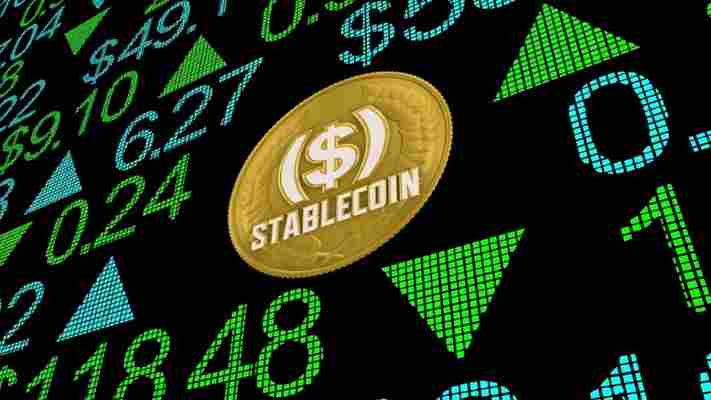Cryptocurrencies have had an exceptional year, reaching a combined value of more than US$3 trillion (£2.2 trillion) for the first time in November. The market seems to have benefited from the public having time on their hands during pandemic lockdowns. Also, large investment funds and banks have stepped in, not least with the recent launch of the first bitcoin-backed ETF – a listed fund that makes it easier for more investors to get exposure to this asset class.

Alongside this has been an explosive rise in the value of stablecoins like tether, USDC and Binance USD. Like other cryptocurrencies, stablecoins move around on the same online ledger technology known as blockchains. The difference is that their value is pegged 1:1 to a financial asset outside the world of crypto, usually the US dollar.
Stablecoins enable investors to keep money in their digital wallets that is less volatile than bitcoin, giving them one less reason to need a bank account. For a whole movement that is about a declaration of independence from banks and other centralized financial providers, stablecoins help to facilitate that. And since the rest of crypto tends to go up and down together, investors can protect themselves better in a falling market by moving money into stablecoins than, say, selling their ether for bitcoin.
A substantial proportion of buying and selling of crypto is done using stablecoins. They are particularly useful for trading on exchanges like Uniswap where there is no single company in control and no option to use fiat currencies. The total dollar value of stablecoins has shot up from the low US$20 billion a year ago to US$139 billion today. In one sense this is a sign that the cryptocurrency market is maturing, but it also has regulators worried about the risks that stablecoins could pose to the financial system. So what’s the problem and what can be done about it?
The problem with stablecoins
Initially introduced in the mid-2010s, stablecoins are centralized operations – in other words, someone is in control of them. Tether is ultimately controlled by the owners of the crypto exchange Bitfinex, which is based in the British Virgin Islands. USDC is owned by an American consortium consisting of payments provider Circle, bitcoin miner Bitmain and crypto exchange Coinbase. Binance USD is owned by Binance, another crypto exchange, which is headquartered in the Cayman Islands.
There is a philosophical contradiction between the decentralized ideal of cryptocurrencies and the fact that such an important part of the market is centralized. But also, there are serious questions about whether these organizations hold enough financial reserves to be able to maintain the 1:1 fiat ratios of their stablecoins in the event of a crisis.
These 1:1 ratios are not automatic. They depend on stablecoin providers having reserves of financial assets equivalent to the value of their stablecoins in circulation, which adjust with supply and demand from investors. The providers promise they have reserves worth 100% of the value of their stablecoins, but that’s not quite accurate – as can be seen in the charts below.
Tether reserves
USDC reserves
Tether holds 75% of its reserves in cash and equivalents as of March 2021. USDC has 61% as of May 2021, so both are someway short of 100%. A large part of the assets of both operations are based on commercial paper , which is a form of short-term company debt. This is not cash equivalent and poses a solvency risk in the event of a sudden collapse in the value of these assets.
So what could derail the machine? Currently, there is almost unlimited money in circulation, interest rates are still at record lows and with the US government having just voted to accept another economic stimulus package worth US$1.2 trillion, the supply of money is not likely to be reduced significantly any time soon. The only element that could challenge this abundance of money is inflation.
There are several possible inflation scenarios, but the market currently still considers the “goldilocks” scenario to be the most likely, with inflation and growth rising together at high but manageable levels. In this case, central banks can let inflation run at 3%-4% levels.
But if the economy overheats , it could lead to an explosive situation of high inflation and economic recession. Lots of money would be moved out of risky assets and bonds into safer havens like the US dollar. The value of those riskier assets, including commercial paper, would fall off a cliff.
This would seriously damage the value of the reserves of stablecoin providers. Many investors with their money in stablecoins might panic and try and convert their money into, say, US dollars, and the stablecoin providers might be unable to give everyone their money back at a 1:1 ratio. This could drag down the crypto market and potentially the financial system as a whole.
Regulatory actions
Regulators are certainly worried about the stability of stablecoins. A US report published a few days ago by the President’s Working Group on Financial Markets said that they potentially pose a systemic risk, not to mention the danger that a huge amount of economic power could end up concentrated in the hands of one provider.
In October , the US Commodity Futures Trading Commission fined Tether US$41 million for claiming to be 100%-backed by fiat currency between 2016 and 2019. Bank of England Governor Andrew Bailey said in June that the bank was still deciding how to regulate stablecoins but that they had some “difficult questions” to answer.
Overall, however, it seems that the response from the regulators is still tentative. The President’s Working Group report recommended stablecoin providers be forced to become banks, but delegated any decisions to Congress. With several big providers and such a burgeoning international market, my worry is that stablecoins may already effectively be too big and disparate to control.
It is possible that the risks will reduce as more stablecoins arrive on the market. Facebook/Meta has well publicized plans for a stablecoin called Diem, for instance. Meanwhile, central bank digital currencies (CBDCs) will put fiat currencies on the blockchain if and when they arrive. The Bank of England is to consult on a digital pound, for example, while the EU and especially China are also moving ahead here. Perhaps the systemic risks of stablecoins will be reduced in a more diversified market.
For now, we wait and see. The speed at which this unnerving risk has emerged is certainly a concern. Unless governments and central banks move up a gear on regulation, a 2008-style crisis in digital assets cannot be ruled out.
Article by Jean-Philippe Serbera , Senior Lecturer, Sheffield Hallam University
This article is republished from The Conversation under a Creative Commons license. Read the original article .
Bill Gates commits $750M to help Oxford vaccinate the world against COVID-19
The Bill and Melinda Gates Foundation has contributed $750 million towards the manufacturing and distribution a potential COVID-19 vaccine developed by Oxford University.

The funds come as part of a deal with British-Swedish pharmaceutical firm AstraZeneca, who’s joined forces with organisations fighting to protect the world against infectious diseases like COVID-19: the Serum Institute of India (SII); the Coalition for Epidemic Preparedness Innovations (CEPI); and the Gavi Vaccine Alliance (Gavi) — of which the latter two are directly funded by Gates.
Gates’ millions will support the delivery of 300 million doses of the vaccine, confusingly dubbed AZD1222, with the first shipments expected to begin by the end of 2020.
A separate licensing agreement with SII will see one billion doses sent to low-and-middle income countries, with 400 million supplied before 2021.
In total, AstraZeneca says it can manufacture two billion doses of AZD1222 “ at no profit during the pandemic,” with the US and the UK reportedly scheduled to receive 300 million and 100 million doses already.
For Gates, this is about saving time, not money
The move is in line with Gates‘ strategy for fast-tracking a COVID-19 vaccine: simultaneously develop seven vaccines and hope one of them works — even if it “wastes” billions of dollars.
Indeed, there’s no guarantee that AZD1222 will actually prove effective. Not to mention, the first proof will reportedly come in August , at the earliest.
Still, Oxford University is starting Phase II/III trials of AZD1222 with about 10,000 adult volunteers. AstraZeneca noted there were late-stage trials due to begin in a number of countries.
“AstraZeneca recognises that the vaccine may not work but is committed to progressing the clinical programme with speed and scaling up manufacturing at risk,” said the firm.
Bill Gates says he’s not into any ‘microchip-type thing’
Gates has finally aired his frustration with a persistent conspiracy theory that posits the Microsoft co-founder secretly lusts to surveil the human race by implanting them with microchips posing as COVID-19 vaccines.
It sounds ridiculous (‘cos it is), but the whacky story has become a movement that’s uniting the wellness and tinfoil hat crowds with alarming efficiency.
“I’ve never been involved any sort of microchip-type thing,” Gates recently told Business Insider . “It’s almost hard to deny this stuff because it’s so stupid or strange.”
Twitter’s Bitcoin scam hack wiped $1B from its market value
Twitter lost nearly $1 billion from its market cap following a devastating hack that saw accounts belonging to a raft of celebrities — including those used by Elon Musk and Warren Buffet — simultaneously hijacked to promote a Bitcoin scam.

Twitter stock opened 4% lower on Thursday morning, which valued the Jack Dorsey-led firm at $27.02 billion, down from almost $28 billion at the previous day’s close.
While $TWTR remains in the green for the year-to-date (up 5% in 2020), it trails significantly behind the tech-heavy NASDAQ 100, which has risen nearly 20% over the same period.
Like previous iterations of the Twitter scam, users were promised double their cryptocurrency in return for any Bitcoin sent to a specific address. Wednesday’s hack, likened to a “smash and grab” operation , affected dozens of accounts belonging to famous companies, celebrities, social media influencers, and global politicians.
At pixel time, one of the addresses promoted by the hijacked accounts had netted more than $116,000 worth of Bitcoin. It’s unclear how much of that came as the result of the plot, as scammers commonly add their own cryptocurrency to the addresses in a bid to convince others of their legitimacy.
The full extent of the security breach isn’t yet understood, but Twitter has confirmed hackers compromised its internal systems and tools. This has led some to speculate that it could’ve been an inside job .
For what it’s worth, Facebook stock fell around 3% in the wake of September 2018 data breach that affected 50 million users, which wiped $16 billion from its market value.
But remember: trade has only just opened. With the situation still fluid thanks to Twitter’s ongoing investigation, the reality is that anything could happen during today’s trade, including Twitter stock rising by market close.
Stranger things have happened in this year’s market.











